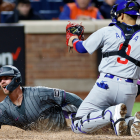Entering the offseason, we ranked former Arizona Diamondbacks southpaw Patrick Corbin as the best starting pitcher on the free-agent market. The reasons were obvious: He's left-handed, on the sunny side of 30, and coming off a banner season that saw him post new career-bests in ERA+ (137), strikeout-to-walk ratio (5.13) and most of the other important rate stats. It's no surprise then that Corbin is drawing interest from the Philadelphia Phillies, New York Yankees and other contenders looking for a front-of-the-rotation boost.
Whenever a player establishes a new benchmark in a walk year, there's going to be concerns about sustainability. Did the player really find a new gear -- or did they enjoy a well-timed fluke? In Corbin's case, there's reason to think it's the former. Part of it is the nature of pitching. Whereas hitting is reactionary -- see ball, hit ball -- pitching is all about establishing the action. They get to pick the pitch and the spot, and their execution often determines what happens next. That means tweaks can be easier to identify and feel more legitimate in nature.
Sure enough, the accepted narrative surrounding Corbin's ascent has to do with an altered pitch mix. In the simplest terms, he became monomaniacal in throwing his breaking balls.
Last season Corbin threw his slider 41.5 percent of the time, according to Brooks Baseball. Additionally, he introduced a curveball -- one that he came up with during a no-hit bid -- that represented another 8.8 percent of his pitches. Corbin, then, threw roughly half breaking balls. For context: He'd never thrown his slider more than 30 percent of the time prior to 2017.
Despite Corbin's increased reliance upon his slider, the pitch yielded more whiffs-per-swing than ever before. Batters came up empty on more than 53 percent of their attempts. It'd be easy to look at Corbin's walk rate and assume he pounded the zone, but that's not the case. Rather, he lived on the fringes of the zone and was able to induce chase after chase with his slider -- a fact that speaks to the pitch's nastiness, as well as his ability to set it up with well-placed fastballs. The curve, meanwhile, proved to be a handy first-pitch offering to toss at right-handed batters.
That's what Corbin did. What teams have to figure out is what he'll do going forward.
Because of Corbin's talent and willingness to try a new approach -- in an important individual year, no less -- it's tempting to believe he'll continue to be this good for another few seasons. He is a pitcher, however, and that means there's an unknowable injury risk associated with any and all long-term forecasts. It doesn't help that Corbin already has underwent Tommy John surgery in the past. That he throws a lot of breaking balls could be another red flag for any team who believes their usage is connected in some way to elbow injuries.
Even with the risk, Corbin is certain to receive a massive contract over the coming weeks. Where his career goes from here is anyone's guess. But expect his slider and curveball to dictate the parts not controlled by his health and fastball command.






















